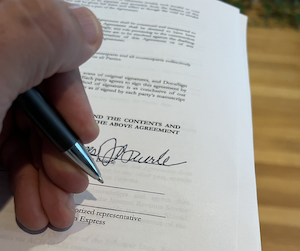Breach of Contract Litigation: Show Me the Contract!
 Many clients ask us, how long will my civil litigation case actually take — for breach of contract, property damage, or physical injuries?
Many clients ask us, how long will my civil litigation case actually take — for breach of contract, property damage, or physical injuries?
The answer is, “It depends. Could be a while.”
This is because the Complaint — filed to enforce one’s claims — need not contain any evidence (just allegations). Next, the Defendant files an “answer,” which are denials and counter allegations. Then, the parties exchange evidence. This sequence of events makes it hard to get to the “meat” of the case right away, except in one area of law: breach of contract litigation.
In Pennsylvania (state court), the plaintiff must attach a copy of the contract to the lawsuit (the Complaint). This places a hefty burden to identify — early on — the exact agreement that Plaintiff seeks to enforce. Perhaps the parties had multiple agreements. Which agreement is being placed at issue as operative? To get the answer, the Defendant need not serve written discovery. Rather, he can file objections to the Complaint, pursuant to Pa.R.C.P. 1019.
Pennsylvania State Court has Rule 1019(h) and (i)
Here’s the exact rule. Pennsylvania Rule of Civil Procedure 1019 (h) and (i) provide:
Notice the burden that Rule 1019 places on a Plaintiff enforcing an agreement: he must plead — right up front — whether any portion of the contract had been oral or in writing. If any portion had been in writing, the Plaintiff must attach the written portions to his Complaint. Or, the Plaintiff must plead why the written portions are unavailable.
Breach Of Contract is Different From Injury Law
It’s worth noting: breach of contract litigation is the only area of law where a party must affirmatively plead evidence (the contract) at the outset of every case. For example, by contrast, let’s say a car strikes a pedestrian named Sally. Then, Sally sues for injuries, filing a complaint. There, the court will preclude Sally from attaching to her complaint the police report or other evidence that the Defendant had negligently operated his vehicle to strike her.
Why is Sally’s injury claim so different from a breach of contract claim?
Role of the Judge versus a Jury in Contract Law Matters
In Sally’s case, above, the defendant has the right to ask a jury to evaluate his alleged negligence. For example, he could claim that Sally had jogged in front of his vehicle, unexpectedly. Thus, it’s not proper for Sally to attach to her complaint only a portion of the evidence. Eventually, a jury will see all the admissible evidence, to evaluate her claims. Did video of the accident surface after the police report had been prepared? Hence, the Complaint is not the place to evaluate “evidence” regarding an injury claim.
In a contract law case, by contrast, it’s the role of the judge — not the jury — to interpret the contract. In Steuart v. McChesney, 444 A.2d 659, 498 Pa. 45 (1982), the PA Supreme Court noted:
“When the parties have reduced their agreement to writing, the writing is to be taken to be the final expression of their intention.” 17A C.J.S. Contracts § 296(2). “Where the contract evidences care in its preparation, it will be presumed that its words were employed deliberately and with intention.” 17A C.J.S. Contracts § 296(2). “In determining what the parties intended by their contract, the law must look to what they clearly expressed. Courts in interpreting a contract do not assume that its language was chosen carelessly.” Moore v. Stevens Coal Co., 315 Pa. at 568, 173 A. at 662.
A Judge May Dismiss a Claim for Breach of Contract Early On
A court looking at a contract attached to a Complaint can decide that the allegations for “breach of contract” are total nonsense — even without the Defendant answering the lawsuit! In eToll, Inc. v. Elias/Savion Advertising, 811 A.2d 10 (Pa. Super. Ct. 2002), the Plaintiff claimed the Defendant had a contract together, also claiming the Defendant engaged in “fraud” and “professional negligence.” Only, the Court read the complaint and determined that — upon reading the contract — Plaintiff’s claims lacked validity. The “gist of the action” was for breach of contract, but nothing in the contract supported Plaintiff’s claims. The lower court dismissed Plaintiff’s claims — short of Defendant filing an answer or serving written discovery. The appellate court agreed.
Allegheny County Exception: Cases Under $3,000
Allegheny County’s local rule provides a simple form for filing cases under $3,000. Here, the Plaintiff need not attach a copy of the contract to the Complaint. Click here for a copy of the form. Thus, ironically, in very small cases, the Plaintiff can play “hide-the-ball” with the contract early on, but in a $1B case, the Plaintiff must produce the agreement immediately upon filing suit for breach of an agreement.
Pleading Breach of Agreement in Federal Court
Federal court is different. Unlike claims filed in the Court of Common Pleas in PA (as governed by Pa.R.C.P. 1019), no such rule exists in the federal court system. As such, in federal court, the Plaintiff need not attach a copy of the contract she is seeking to enforce.
Let’s Get Started!
Call or email a Pittsburgh lawyer at our firm about any lawsuit for breach of contract!
412.342.0992

